World renowned for its immense glacial polished granite, Yosemite is the mecca for rock climbers. For nearly two centuries, from the days of scrambling peaks in the Sierra to the cutting edge free climbing on El Capitan, the cliffs of Yosemite National Park have set the standards for climbing.
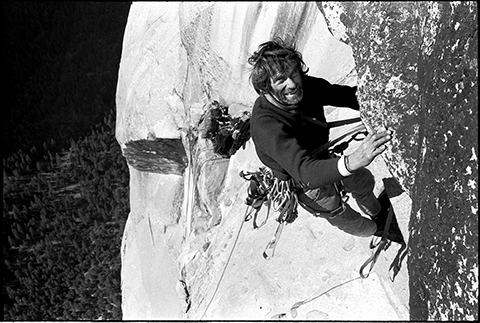
Warren Harding topping out on the first ascent of the Nose of El Capitan.
The earliest climbers in Yosemite summated the granite formations in the most rudimentary ways possible. In 1869, naturalist John Muir climbed the technical Cathedral peak in the northern Sierra ropeless. Six years later, George Anderson employed eyebolts, drilled hand and foot holds and fixed rope to summate Half Dome. Through the history of Yosemite, there would remain a stark contrast between the minimalist style and the heavy-handed siege tactics.
For over fifty years, climbers in Yosemite climbed the formations at great personal risk. It wasn’t until the 1930s, when Robert Underhill, after a season in the Alps, brought the use of pitons and rappelling to Yosemite. Over the next decade, California climbers develop rope techniques for catching and holding falls. They also imported pitons from Europe. The climbers hammered the metal into the rock and used it as a means to ascend, aid climbing, The advancements in rope and gear contributed significantly to climbers summating the Cathedral Spires and other formations during the decade.
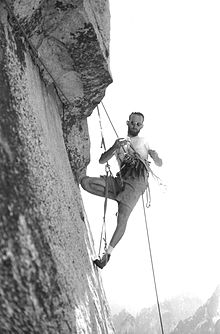
Royal Robbins and Tom Frost hanging in hammocks on the first ascent of the North America Wall. Frost photo.
In the mid 1940s, a San Mateo black smith, John Salathe revolutionized the piton game when he joined the climbers at the Sierra Club lodge in northern Yosemite. Salathe used his experience as a blacksmith to create hard steel pitons from the axels of an old Ford Model A. The pitons worked significantly better in the hard granite of Yosemite than the European soft iron models. Salathe began climbing extensively in Yosemite, making the first attempt on the Lost Arrow Spire, climbing the Southwest face of Half Dome and making the first ascent of the Steck-Salathe on the Sentinel over the course of five days.
The 1950s saw one of climbing’s greatest rivalry. The two greatest prizes of Yosemite, the faces of Half Dome and El Capitan, remained unclimbed. In 1957, Harding raced his Corvette to Yosemite Valley to climb the Northwest face of Half Dome only to find Royal Robbins on the route already. With the help of Jerry Gallwaas, Robbins completed the five day first ascent of the Regular Northwest Face, Yosemite’s first grade VI climb. With Half Dome climbed, Harding took to the last prize of Yosemite. Over 47 days spread out in a year and a half period, Harding fixed a long series of ropes up the Nose of El Capitan. In November of 1958, Harding, George Whitemore and Wayne Merry made a record 12-day push for the summit. The highly publicized ascent cemented the wine drinking Harding as a hero and forced Robbins to the cliffs.
The 1960’s saw Robbins making a quick second ascent of Harding’s Nose route on El Capitan followed by an ascent of the Salathe Wall on the Southwest face of El Capitan with two other Valley climbers. Robbins, Chuck Pratt and Tom Frost climbed the Salathe Wall with only 13 bolts and sparse use of fixed ropes, making a 6-day summit push from 600 feet up the wall. Robbins ascent proved that El Capitan could be climbed without siege tactics.
Harding and Robbins continued to attempt to out climb each other. The steep West Face of the Leaning Tower and the remote South Face of Mount Watkins fell to Harding. Robbins answered with the first solo of a big wall route, climbing the West Face of Leaning tower in a storm. Along with Tom Frost and Yvon Chouinard, Robbins climbed the North America Wall on the Southeast face of El Capitan, completing the most difficult climb to date.
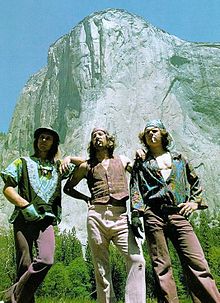
Billy Westbay, John Long and Jim Bridwell standing in front of El Capitan after the first one day ascent of the Nose.
During Robbins and Harding’s fight for Yosemite big wall supremacy, other Yosemite climbers raised free climbing standards and shortened ascent times. The Steck-Salathe, the Regular Northwest Face of Half Dome and other Yosemite walls fell to single day ascents. Using only nuts and not the rock damaging pitons, Robbins and his wife, Liz climbed The Nutcracker on Manure Pile Buttress. Their clean ascent of the 800-foot route established a new ethic for climbing. Free and clean became the standard.
The 1970’s saw an increase in the number of climbers and a greater focus on free climbing. Advanced climbing gear allowed climbers to link delicate features on the sides of El Capitan. Jim Bridwell established a number of futuristic routes, including the Aquarian Wall, Pacific Ocean Wall and Zenyatta Mondatta. Beyond the advances in aid climbing, the 70’s saw a jump in the free-climbing standards. Sticky rubber shoes helped climbers stand on smaller edges. Bridwell lead the Stonemasters, a group of Yosemite climbers, into the new world of free climbing. The Yosemite Decimal system went from 5.0 to 5.9 but during the 70’s, Bridwell expanded the rating system to an open ended scale, introducing 5.10 and including the sub A, B, C and D grades. Bridwell furthered the standards of Yosemite by climbing The Nose with John Long and Billy Westbay in a single day. John Long, John Bachar and Ron Kauk, three of the most influential Stonemasters, free climbed the East Face of Washington Column completing the first ascent of the sustained Astroman. In the middle of Camp 4, the Stonemasters left their mark, drawing a lightning bolt below Midnight Lightning, a boulder problem established by Kauk and Bachar and recognized as one of the hardest climbs in the world at the time.
The 1980’s saw greater advancements in free climbing. Todd Skinner and Paul Piana managed a team free ascent of the Salathe Wall, ushering the concept that El Capitan was a place for free climbing. John Bachar, Bill Price and Ray Jardine all established 5.13 routes and Canadian Peter Croft climbed Astroman without a rope. Camming devices made protecting difficult cracks easier and faster, which greatly raised free climbing standards. More notably was the punch thrown in Camp 4. Ron Kauk visited Europe in the 80’s and returned to Yosemite with a top down ethos. John Bachar feared that the adventure of climbing would be lost with the European tactics of rehearsal and inspection. A fight ensued between the friends when Bachar chopped the protection bolts on Kauk’s Punchline route. When the dust settled, Bachar’s ground up ethic was left behind to pushing climbing harder.
In the early 90s, climbers began drag racing up El Capitan with Peter Croft and Dave Schultz climbing the Nose in under 5 hours. More impressively, Lynn Hill made the first true free climb of El Capitan, with an ascent of the Nose. She returned a few years later to free climb the route in a single day. Hill made the first true free ascent of El Capitan. Later in the decade two Austrian brothers, Alex and Thomas Huber stormed through Yosemite, adding to El Capitan free climbing. After freeing the Salathe Wall, they established El Nino, Freerider and Golden Gate.
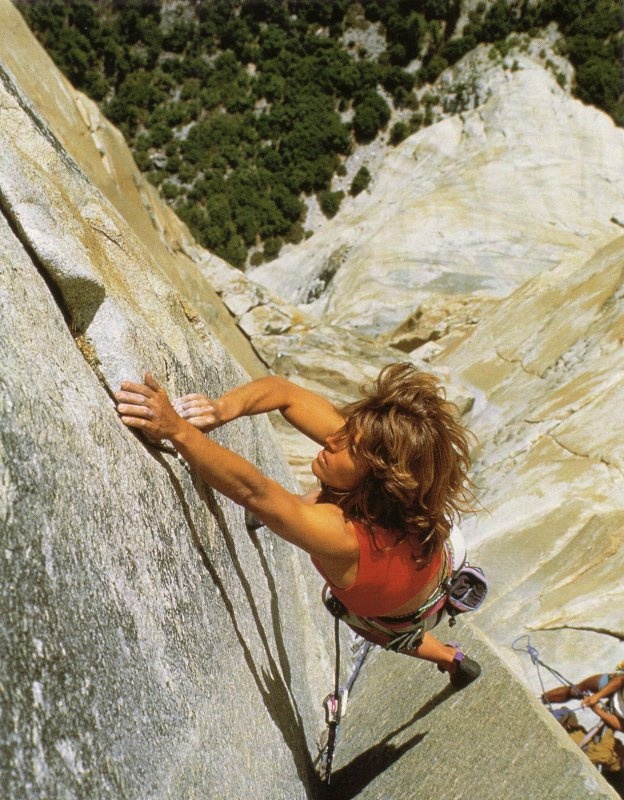
Lynn Hill on the Nose
The early 2000s saw the Huber Baum continue their El Capitan free exploits. They freed El Corazon and the Zodiac, which they then blitzed in one hour fifty-one minutes. Other climbers raced up El Capitan as well with the Nose speed recording dropping from 4 hours to just over 2. Tommy Caldwell brought American talents to El Capitan, repeating many of the Huber’s free routes and establishing other free routes including Lurking Fear, West Buttress, Dihedral Wall, Magic Mushroom and the Muir. He climbed a number of El Capitan routes in a day. In 2005, Caldwell free climbed the Nose and Freerider in a single day. Caldwell turned to the steep section of the Dawn Wall, which he has been working on free climbing for the past decade. When he completes the route, it will be the hardest long free climb in the world. In mid 2000s Alex Honnold began climbing in Yosemite as well, free soloing Astroman, the difficult Phoenix and making the first free solo ascent of the Regular Northwest Face of Half Dome. His steel-trap mind allowed him to set numerous speed records on El Capitan and do an enormous free climbing linkup with Tommy Caldwell of El Capitan, Half Dome and Mount Watkins in a single day.
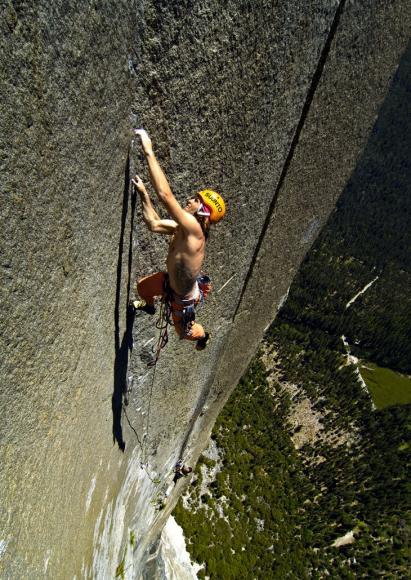
Thomas Huber climbing on El Capitan
The past few years have seen other climbers freeing new routes on Middle Cathedral, Mount Watkins and the smaller formations in the Valley. The ability of the average climber has increased dramatic with single day ascents of El Capitan happening regularly. El Capitan becomes more accessible and easier to free climb every year and climbers like Caldwell continue to raise the standards. The future of Yosemite remains unpredictable but very promising.

Yosemite legend, Tommy Caldwell working his project, attempting to freeclimb the Dawn Wall.

